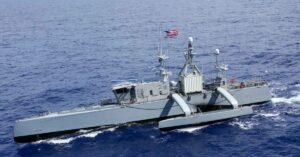
Inmarsat Maritime Unveils NexusWave, Revolutionising Maritime Communications
May 21, 2024
Rising Sea Levels Threaten Global Oil Shipments, Recent Study Warns
May 22, 2024

The US Navy has formed a new unit to help the service successfully integrate small but advanced maritime drones into its forces.
Unmanned Surface Vessel Squadron Three, under the command of Captain Derek Rader, will oversee a “fleet” of small uncrewed surface vessels known as the Global Autonomous Reconnaissance Craft (GARC).
USVRON Three’s establishment is the most recent move in the sea service’s journey to building a hybrid fleet comprising manned and unmanned systems.
It came roughly three months after the chief of naval operations, Adm. Lisa Franchetti, introduced a robotics warfare specialist general rating.
RW Sailors will enable Robotic and Autonomous System operations and maintenance at the tactical edge.
According to a NAVADMIN declaration from Franchetti, RWs will serve as the subject matter specialists for mission autonomy, computer vision, navigation autonomy, data systems, AI, and machine learning on the Robotic and Autonomous System platforms. Those specialists will be part of the new squadron, per the service.
The Navy has been placing unmanned systems in the hands of 400 highly talented warfighters to aid in the integration, scaling, experimentation, and employment of these systems, Brendan McLane, Vice Adm., the commander of Naval Surface Forces US Pacific Fleet, mentioned during a speech at the May 17 ceremony to earmark the establishment of the USVRON Three.
The squadron was formed as the Pentagon advanced its Replicator initiative, which strives to accelerate the programs and field thousands of autonomous systems across domains by August 2025 to aid the US armed forces in countering the Chinese military buildup.

The Pentagon reportedly has secured $500 million in funding for the first tranche in fiscal 2024 and has requested an additional $500 million for FY 2025.
The Navy is currently pursuing various unmanned surface vessels via the Replicator, including via a collaboration with the Defense Innovation Unit.
Earlier this year, the DIU solicited small and autonomous maritime drones that can operate in packs to monitor and engage adversaries’ vessels.
During a congressional hearing last week, Nickolas Guertin, the acquisition chief associated with the Department of the Navy, mentioned that the DON supports the Replicator, but he further noted that it is not a mere matter of scaling production.
Guertin informed the lawmakers that another aspect is that when they look at such initiatives, they try to ensure that they carry forward the sustainability and support work to ensure that the service members can use such stuff more reliably when they need to in a fight.
Other officials have also noted that the military needs to flesh out the tactics, techniques, procedures, and training for employing next-gen uncrewed systems.
Even though the Navy’s release last week about USVRON Three didn’t explicitly mention Replicator or link the unit to that effort, its future work could facilitate the integration of those types of systems into the fleet.
The USVRON Three’s mission is to successfully introduce the most impressive unmanned platforms in the broader maritime domain.
According to the release, the squadron will be a cornerstone in developing the foundational knowledge needed to operate and maintain USVs.
It will head the development of TTPs for USV operations and sustainment.
SURFDEVGRU 1 will maintain, staff, and train unmanned surface vehicles, guided missile destroyers belonging to the Zumwalt class, and the upcoming USS Lyndon B. Johnson (DDG 1002).
CNSP’s objective is to man, train, and enable the Surface Force so that the fleet commanders have credible naval strength to control the sea and project power ashore.
Reference: US Navy
U.S. Navy Establishes Unmanned Surface Vessel Squadron Three At Naval Amphibious Base Coronado appeared first on Marine Insight – The Maritime Industry Guide
Source: Maritime Shipping News


